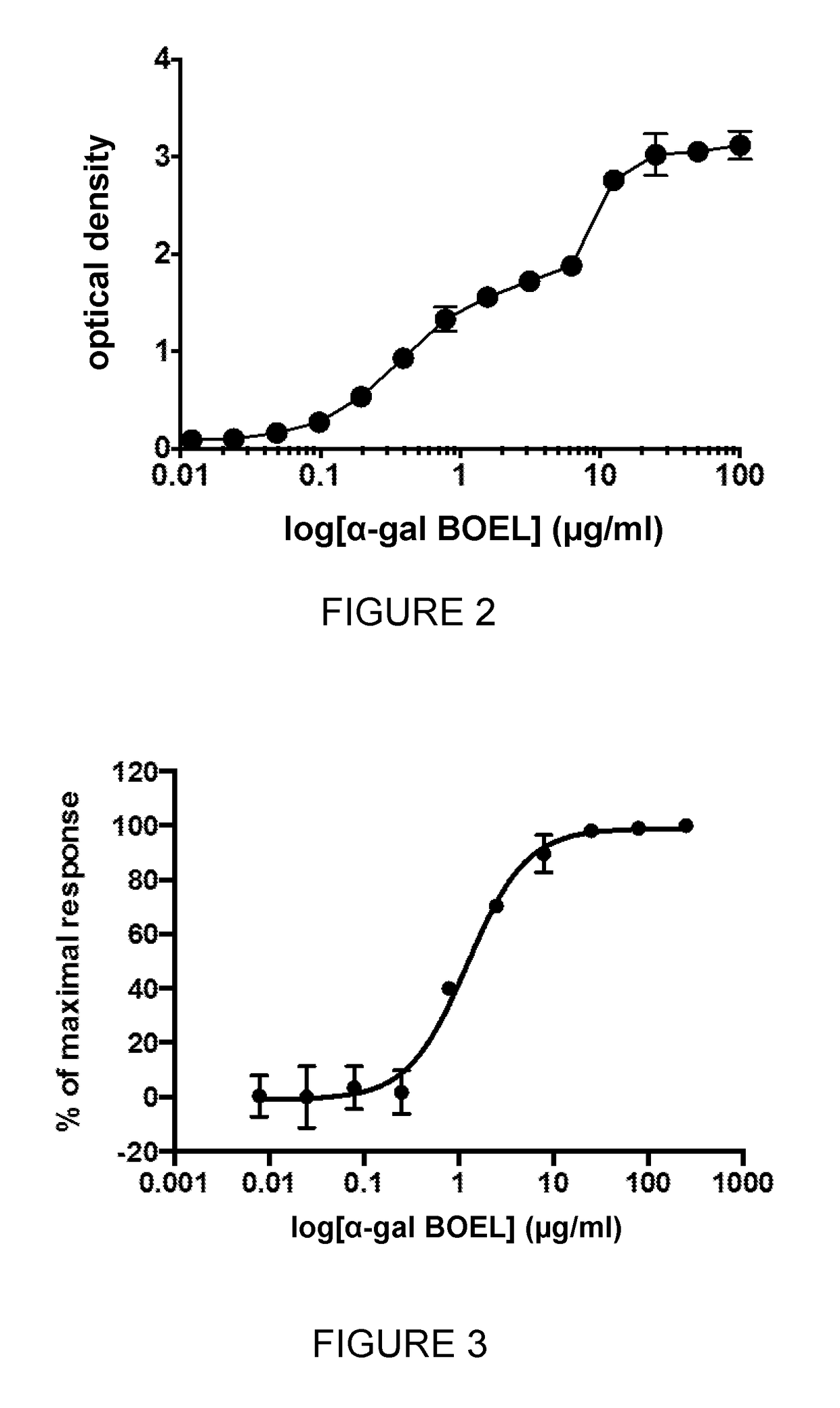Glycolipid containing compositions for use in the treatment of tumours
- Summary
- Abstract
- Description
- Claims
- Application Information
AI Technical Summary
Benefits of technology
Problems solved by technology
Method used
Image
Examples
example 1
Demonstrate Binding to Anti-Gal Antibodies
[0249]A 96-well plate is first coated with α-Gal BOEL (obtained from Sigma as FSL-Galili(tri)™, Catalogue No. F9432). 50 μL PBS is added to each well. α-Gal BOEL is resuspended in PBS to a concentration of 2 mg / ml and 50 μL added to a well. Serial dilutions are performed by transferring 50 μL into wells across the plate making sure that each well is thoroughly mixed before transfer. The plate is left overnight to dry. This results in strong adherence of α-Gal BOEL to the wells by the L (lipid) portion of this molecule.
[0250]150 μL of blocking buffer (1×PBS / 1% BSA) is added to the dry wells. The plate is covered and incubated at 37° C. for 2 hours. The well contents are discarded and the wells washed with PBS. 50 μL of the primary anti-Gal antibody (monoclonal mouse anti-Gal IgM in this example, M86 hybridoma supernatant) is added to each well. The plate is incubated at room temperature for 2 hours. The plate is washed 3 times with 200 μL was...
example 2
t-Dependent Cytotoxicity and Incorporation Assays
[0253]The assays below quantify both the amount of α-Gal BOEL inserted into the cell plasma membranes and the functional impact of α-Gal BOEL insertion in stimulating anti-Gal mediated complement-dependent cytotoxicity (CDC). α-Gal BOEL is titrated and incubated with CHO-K1 cells. These cells are either fixed and used in a whole cell ELISA assay, to determine incorporation of α-Gal into membranes, or incubated with anti-Gal antibody and human serum to measure CDC (or general cytotoxicity in the absence of complement from human serum).
[0254]α-Gal BOEL Titration and CHO-K1 Cell Preparation
[0255]α-Gal BOEL is titrated as follows. One 40 μl aliquot of α-Gal BOEL (2 mg / ml (obtained from Sigma as FSL-Galili(tri)™, Catalogue No. F9432)) is thawed and sonicated for 30 seconds. 40 μl of phosphate buffered saline (PBS) is added to the tube and vortexed for 10 seconds. 25 μl of this mix is added to 55 μl of PBS and mixed well. These dilutions ar...
example 3
t Deposition Assays
[0270]1×106 B16-F10 and CHO-K1 cells were harvested from growing cultures and incubated with 500 μg / ml αGal BOEL in PBS for 1 hour at 37° C., after which the cells were washed 3 times with PBS. After washing the CHO-K1 cells were incubated with either 2.5% normal (NHS) or heat-inactivated (HI NHS) human serum for 10 minutes at 37° C. The B16-F10 cells were incubated with either 2.5% serum from normal GT− / − mice (NMS) or 2.5% serum from pig kidney homogenate immunised mice (I NMS) for 10 minutes at 37° C. The cells were placed on ice and washed twice with ice-cold cell staining buffer (PBS+0.1% BSA). The cells were incubated with either anti-C3b (C3b, Pierce MAI-70054, diluted 1:1000 in cell staining buffer) or anti-SC5b-9 (MAC, Quidel A239, diluted 1:100 in cell staining buffer) for 30 minutes on ice. The cells were washed twice with ice cold cell staining buffer and incubated with FITC goat anti-mouse IgG (Abcam ab97022, diluted 1:2000 in cell staining buffer) fo...
PUM
 Login to View More
Login to View More Abstract
Description
Claims
Application Information
 Login to View More
Login to View More - R&D
- Intellectual Property
- Life Sciences
- Materials
- Tech Scout
- Unparalleled Data Quality
- Higher Quality Content
- 60% Fewer Hallucinations
Browse by: Latest US Patents, China's latest patents, Technical Efficacy Thesaurus, Application Domain, Technology Topic, Popular Technical Reports.
© 2025 PatSnap. All rights reserved.Legal|Privacy policy|Modern Slavery Act Transparency Statement|Sitemap|About US| Contact US: help@patsnap.com



